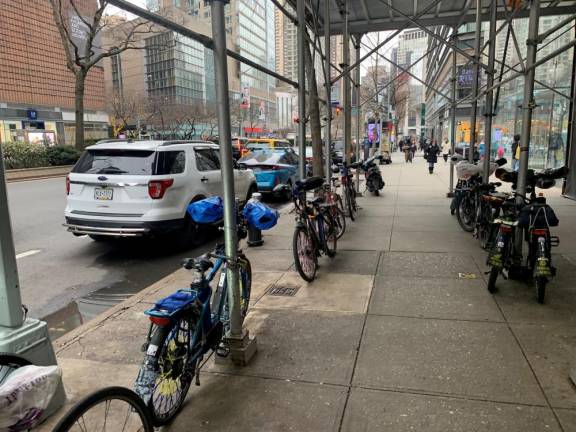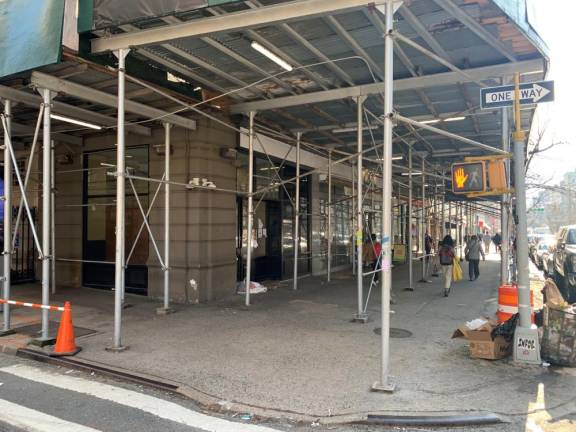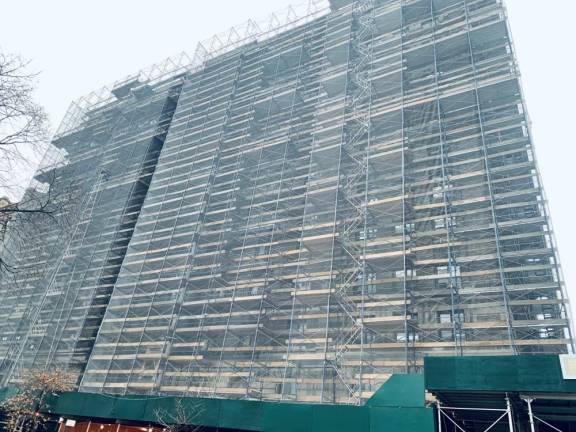Scaffolding and Sidewalk Enclosures: Why So Many and Why Now?
Currently there are 4,000 “shed” permits as scaffolding is known in building code parlance. One shed has been up for 16 years



We are all too aware of the scaffolding and pedestrian sheds are forced to navigate during our days and nights, some good, some bad, and some just beyond belief. Many in residential areas have become de facto e-bike garages, homeless hotels, and unventilated cannabis smoking lounges.
As the average Manhattan building age increases with every year, and housing in short supply, many building elements rapidly deteriorate. There are now over 4,000 shed permits currently issued in Manhattan alone, almost half of all permits in New York City. According to NYC buildings, the duration statistic cited is 243 days, but we all know scaffolding up for many more months or even years exist in our midst.
In one more extreme case, the sidewalk shed over the popular UWS Hi-Life Bar entrance was removed in late January after 10 years while employees and regulars rejoiced over its demise. In another instance, a West Side apartment building has had a scaffold attached to their building for sixteen years.
The Reasons Behind Scaffolding Laws
The first NY State Scaffolding Law went into effect in 1885; at that time, certainly few, if any, understood the ramifications of the elevator and the subway that would change Manhattan’s building heights and population density forever.
Fast forward nearly 140 years and stats show that of the current Manhattan sheds related to construction and maintenance, 37 percent are for NYC’s Façade Inspection & Safety Program that has been effect for over 40 years. They are sheds erected to protect pedestrians from falling debris from buildings. The sheds have become more prevalent with an increasing number of aging high rise buildings.
In a long-forgotten incident in 1960, a visiting tourist and his wife were at 57th and Park, when an 8 pound dumbbell, used to prop up a window screen in the building above him, rolled out the open window, struck him in the head, killing him instantly. Once his heirs received a settlement, the event was forgotten by most.
The seminal event that started current legislation occurred in the evening of May 16, 1979, when Grace Gold, a Barnard freshman, walked by 601 West 115th Street. While in front of the building, a one foot by two foot chunk of concrete broke away from the seventh floor and bashed her in the forehead. She died a short time later. With the aging of many prewar buildings that existed in New York City, action needed to be taken.
Death Spurs Changes to Code
A year after the death of Ms. Gold, in 1980, New York City passed Local Law 10, which mandated buildings taller than six stories have their street-facing facades inspected every five years by a qualified engineer or architect for any defects. A change was made in 1998 by Local Law 11( now called FISP) which meant that all facades in a building of seven stories or more be inspected, with at least one street facing facade physically inspected, not just visually.
From Public Safety to Public Nuisance
The sheds underneath the scaffolding? It’s up to the developer, landlord, co-op or condo, whoever is responsible for the building to maintain them. Unfortunately, aside from offering protection to make sure the facades above are safe and sturdy, while they are erected they narrow the walking spaces on the sidewalk, and they are frequently used to tether delivery bikes, afford a degree of protection from the elements for homeless people, as well as assorted panhandlers and vendors. These are the unintended consequences of the building codes meant to protect us.
To shorten shed duration, the then-City Council member Ben Kallos tried in 2016 to enact a bill to give building owners six months to complete Local Law 11 repairs. If they failed to make the repairs, the bill said city employees would finish it and bill the owners. Opposition from real estate and other interests killed the bill in committee.
Who are the scaffold workers? We may not see or hear them as the put up and take down scaffolding, but they are part of the mix, offering a relatively high income for dangerous work. The work draws many immigrants who just want to get a paycheck. Scaffolding contractors do not always follow OSHA standards nor train workers properly. Last year, safety violation incidents tied to scaffolding and sheds led to 5 deaths.
Eight years ago, a 22-year old Ecuadorian immigrant named Carlos Moncayo died , by his employers neglect, placing him in dangerous conditions, For this egregious act, his family was paid the maximum amount which was only $10.000.
At the end of last year, Governor Kathy Hochul signed a bill to amend the New York State Penal Law. The new law increased penalties for criminal corporate liability for the death or serious physical injury of an employee with a fine of up to $500,000. It is named Carlos’ Law, in honor of Moncayo.
Perhaps the groundwork of former Councilman Kallos can be relaunched to insure that the scaffolding and sheds exist for as long as they are truly needed.
No one should have to trod under the same temporary shelter eight months, let alone 10 or 16 years.
Carlos’ Law, named for an Ecuadorian immigrant whose family received only $10,000 when he was killed in a scaffold accident, increased the penalty for death or serious injury due to contractor or owner negligence involving a scaffold, to $500,000